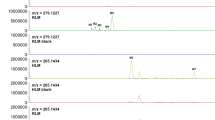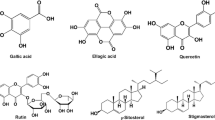Abstract
Background
Lycopene as a naturally occurring carotenoid is a common part of the human diet. Several beneficial properties of lycopene have been identified, with the most studied being anti-cancer and antioxidant activity. However, no evidence of possible drug–drug or drug–food supplement interactions has been found.
Methods
We studied the in vivo effect of lycopene on the selected rat liver cytochromes P450 (CYPs): CYP1A2, CYP2B, CYP2C11, CYP2C6, CYP2D, and CYP3A. Lycopene was administered to rats intragastrically at doses of 4, 20, and 100 mg/kg/day for 10 consecutive days. Total protein content, P450 Content, and metabolic activity of selected CYPs were evaluated in the rat liver microsomal fraction.
Results
Increased CYP2B, CYP2D, and CYP3A metabolic activities were observed in animals treated with the lycopene dose of 100 mg/kg/day. The content of CYP3A1 protein was increased by the dose of 100 mg/kg/day and CYP3A2 protein was increased by all administered doses of lycopene.
Conclusion
The results of our study indicate that lycopene increased the metabolic activity of enzymes that are orthologues to the most clinically important human enzymes involved in xenobiotic metabolism. The risk of pharmacokinetic interactions between lycopene dietary supplements and co-administered drugs should be evaluated.
Graphic abstract







Similar content being viewed by others
References
Rao AV, Agarwal S. Role of antioxidant lycopene in cancer and heart disease. J Am Coll Nutr. 2000;19(5):563–9.
Chasse GA, Mak ML, Deretey E, Farkas I, Torday LL, Papp JG, et al. An ab initio computational study on selected lycopene isomers. J Mol Struct Theochem. 2001;571(1):27–37.
O’Neill ME, Southon S, Corridan B, Olmedilla B, Granado F, Blanco I, et al. A European carotenoid database to assess carotenoid intakes and its use in a five-country comparative study. Br J Nutr. 2001;85(4):499–507.
Rao AV, Waseem Z, Agarwal S. Lycopene content of tomatoes and tomato products and their contribution to dietary lycopene. Food Res Int. 1998;31(10):737–41.
Suwanaruang T. Analyzing lycopene content in fruits. Agric Agric Sci Proc. 2016;11:46–8.
Milani C, Maccari M, Mosconi P. Action of lycopene in the experimental gastric ulcer. Pharmacology. 1970;4(6):334–40.
Di Mascio P, Kaiser S, Sies H. Lycopene as the most efficient biological carotenoid singlet oxygen quencher. Arch Biochem Biophys. 1989;274(2):532–8.
Costa-Rodrigues J, Pinho O, Monteiro PRR. Can lycopene be considered an effective protection against cardiovascular disease? Food Chem. 2018;245:1148–53.
Thies F, Masson LF, Rudd A, Vaughan N, Tsang C, Brittenden J, et al. Effect of a tomato-rich diet on markers of cardiovascular disease risk in moderately overweight, disease-free, middle-aged adults: a randomized controlled trial. Am J Clin Nutr. 2012;95(5):1013–22.
Karppi J, Kurl S, Ronkainen K, Kauhanen J, Laukkanen JA. Serum carotenoids reduce progression of early atherosclerosis in the carotid artery wall among Eastern Finnish men. PLoS ONE. 2013;8(5):e64107.
Giovannucci E, Ascherio A, Rimm EB, Stampfer MJ, Colditz GA, Willett WC. Intake of carotenoids and retino in relation to risk of prostate cancer. JNCI J Natl Cancer Inst. 1995;87(23):1767–76.
Zu K, Mucci L, Rosner BA, Clinton SK, Loda M, Stampfer MJ, et al. Dietary lycopene, angiogenesis, and prostate cancer: a prospective study in the prostate-specific antigen era. JNCI J Natl Cancer Inst. 2014;106(2):430.
King-Batoon A, Leszczynska JM, Klein CB. Modulation of gene methylation by genistein or lycopene in breast cancer cells. Environ Mol Mutagen. 2008;49(1):36–45.
Palozza P, Simone RE, Catalano A, Mele MC. Tomato lycopene and lung cancer prevention: from experimental to human studies. Cancers. 2011;3(2):2333–57.
Vecchia CL. Tomatoes, lycopene intake, and digestive tract and female hormone-related neoplasms. Exp Biol Med. 2002;227(10):860–3.
Nkondjock A, Ghadirian P, Johnson KC, Krewski D. Dietary intake of lycopene is associated with reduced pancreatic cancer risk. J Nutr. 2005;135(3):592–7.
Miller NJ, Sampson J, Candeias LP, Bramley PM, Rice-Evans CA. Antioxidant activities of carotenes and xanthophylls. FEBS Lett. 1996;384(3):240–2.
Stahl W, Junghans A, de Boer B, Driomina ES, Briviba K, Sies H. Carotenoid mixtures protect multilamellar liposomes against oxidative damage: synergistic effects of lycopene and lutein. FEBS Lett. 1998;427(2):305–8.
Sahin K, Kucuk O. Lycopene in cancer prevention. In: Ramawat KG, Merillon JM, editors. Natural products: phytochemistry, botany and metabolism of alkaloids, phenolics and terpenes. Berlin: Springer; 2013. p. 3875–3922. https://doi.org/10.1007/978-3-642-22144-6.
Izzo AA, Hoon-Kim S, Radhakrishnan R, Williamson EM. A critical approach to evaluating clinical efficacy, adverse events and drug interactions of herbal remedies. Phytother Res. 2016;30(5):691–700.
Lowry OH, Rosebrough NJ, Farr AL, Randall RJ. Protein measurement with the folin phenol reagent. J Biol Chem. 1951;193(1):265–75.
Omura T, Sato R. The carbon monoxide-binding pigment of liver microsomes. II. J Biol Chem. 1964;239:2379–85.
Wójcikowski J, Gołembiowska K, Daniel WA. Regulation of liver cytochrome P450 by activation of brain dopaminergic system: physiological and pharmacological implications. Biochem Pharmacol. 2008;76(2):258–67.
Dovrtelova G, Zendulka O, Noskova K, Jurica J, Pes O, Dusek J, et al. Effect of endocannabinoid oleamide on rat and human liver cytochrome P450 enzymes in in vitro and in vivo models. Drug Metab Dispos. 2018;46:913–23.
Dovrtelova G, Noskova K, Jurica J, Turjap M, Zendulka O. Can bioactive compounds of Crocus sativus L. Influence the metabolic activity of selected CYP enzymes in the rat? Physiol Res. 2015;64:S453–8.
Noskova K, Dovrtelova G, Zendulka O, Remínek R, Jurica J. The effect of (−)-linalool on the metabolic activity of liver CYP enzymes in rats. Physiol Res. 2016;65:6.
Tyndale RF, Li Y, Li N-Y, Messina E, Miksys S, Sellers EM. Characterization of cytochrome P-450 2D1 activity in rat brain: high-affinity kinetics for dextromethorphan. Drug Metab Dispos. 1999;27(8):924–30.
Kobayashi K, Urashima K, Shimada N, Chiba K. Substrate specificity for rat cytochrome P450 (CYP) isoforms: screening with cDNA-expressed systems of the rat. Biochem Pharmacol. 2002;63(5):889–96.
Rowles JL, Ranard KM, Applegate CC, Jeon S, An R, Erdman JW. Processed and raw tomato consumption and risk of prostate cancer: a systematic review and dose–response meta-analysis. Prostate Cancer Prostatic Dis. 2018;21:319–36.
Kavanaugh CJ, Trumbo PR, Ellwood KC. The U.S. Food and Drug Administration’s Evidence-based review for qualified health claims: tomatoes, lycopene, and cancer. JNCI J Natl Cancer Inst. 2007;99(14):1074–85.
Kucuk O, Sarkar FH, Sakr W, Djuric Z, Pollak MN, Khachik F, et al. Phase II randomized clinical trial of lycopene supplementation before radical prostatectomy. Cancer Epidemiol Prev Biomark. 2001;10(8):861–8.
Kucuk O, Sarkar FH, Djuric Z, Sakr W, Pollak MN, Khachik F, et al. Effects of lycopene supplementation in patients with localized prostate cancer. Exp Biol Med. 2002;227(10):881–5.
Leoncini E, Nedovic D, Panic N, Pastorino R, Edefonti V, Boccia S. Carotenoid intake from natural sources and head and neck cancer: a systematic review and meta-analysis of epidemiological studies. Cancer Epidemiol Prev Biomark. 2015;24(7):1003–11.
Crooker K, Aliani R, Ananth M, Arnold L, Anant S, Thomas SM. A review of promising natural chemopreventive agents for head and neck cancer. Cancer Prev Res. 2018;11(8):441–50.
Gullett NP, Ruhul Amin ARM, Bayraktar S, Pezzuto JM, Shin DM, Khuri FR, et al. Cancer prevention with natural compounds. Semin Oncol. 2010;37(3):258–81.
Tang Y, Parmakhtiar B, Simoneau AR, Xie J, Fruehauf J, Lilly M, et al. Lycopene enhances Docetaxel’s effect in castration-resistant prostate cancer associated with insulin-like growth factor i receptor levels. Neoplasia. 2011;13(2):108–19.
Kong L, Song C, Ye L, Xu J, Guo D, Shi Q. The effect of lycopene on cytochrome P450 isoenzymes and P-glycoprotein by using human liver microsomes and Caco-2 cell monolayer model. Int J Food Sci Nutr. 2018;69(7):835–41.
Jewell C, O’Brien NM. Effect of dietary supplementation with carotenoids on xenobiotic metabolizing enzymes in the liver, lung, kidney and small intestine of the rat. Br J Nutr. 1999;81(3):235–42.
Porrini M, Riso P. What are typical lycopene intakes? J Nutr. 2005;135(8):2042S–5S.
Acknowledgements
This publication was written with the support of the Specific University Research grant (MUNI/A/1550/2018) provided by the Ministry of Education, Youth and Sports of the Czech Republic and by the Specific University Research Grant (MUNI/A/0976/2018) and by the funds from the Faculty of Medicine, Masaryk University junior researcher Ondrej Pes.
Author information
Authors and Affiliations
Corresponding author
Ethics declarations
Conflict of interest
The authors declare no conflicts of interest.
Additional information
Publisher’s Note
Springer Nature remains neutral with regard to jurisdictional claims in published maps and institutional affiliations.
Rights and permissions
About this article
Cite this article
Nosková, K., Dovrtělová, G., Zendulka, O. et al. Lycopene increases metabolic activity of rat liver CYP2B, CYP2D and CYP3A. Pharmacol. Rep 72, 156–165 (2020). https://doi.org/10.1007/s43440-019-00007-y
Received:
Revised:
Accepted:
Published:
Issue Date:
DOI: https://doi.org/10.1007/s43440-019-00007-y




